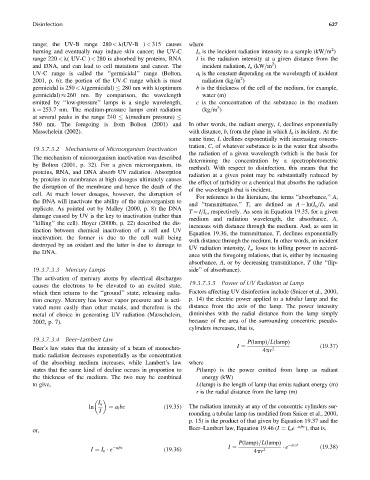Page 672 - Fundamentals of Water Treatment Unit Processes : Physical, Chemical, and Biological
P. 672
Disinfection 627
range; the UV-B range 280 < l(UV-B ) < 315 causes where
2
burning and eventually may induce skin cancer; the UV-C I o is the incident radiation intensity to a sample (kW=m )
range 220 < l( UV-C ) < 280 is absorbed by proteins, RNA I is the radiation intensity at a given distance from the
2
and DNA, and can lead to cell mutations and cancer. The incident radiation, I o (kW=m )
UV-C range is called the ‘‘germicidal’’ range (Bolton, a i is the constant depending on the wavelength of incident
2
2001, p. 6); the portion of the UV-C range which is most radiation (kg=m )
germicidal is 250 < l(germicidal) 280 nm with l(optimum b is the thickness of the cell of the medium, for example,
germicidal) 260 nm. By comparison, the wavelength water (m)
emitted by ‘‘low-pressure’’ lamps is a single wavelength, c is the concentration of the substance in the medium
3
l ¼ 253.7 nm. The medium-pressure lamps emit radiation (kg=m )
at several peaks in the range 240 l(medium pressure)
580 nm. The foregoing is from Bolton (2001) and In other words, the radiant energy, I, declines exponentially
Masschelein (2002). with distance, b, from the plane in which I o is incident. At the
same time, I, declines exponentially with increasing concen-
tration, C, of whatever substance is in the water that absorbs
19.3.7.3.2 Mechanisms of Microorganism Inactivation
the radiation of a given wavelength (which is the basis for
The mechanism of microorganism inactivation was described
determining the concentration by a spectrophotometric
by Bolton (2001, p. 32). For a given microorganism, its
method). With respect to disinfection, this means that the
proteins, RNA, and DNA absorb UV radiation. Absorption
radiation at a given point may be substantially reduced by
by proteins in membranes at high dosages ultimately causes
the effect of turbidity or a chemical that absorbs the radiation
the disruption of the membrane and hence the death of the
of the wavelength that is incident.
cell. At much lower dosages, however, the disruption of
For reference to the literature, the terms ‘‘absorbance,’’ A,
the DNA will inactivate the ability of the microorganism to
and ‘‘transmittance,’’ T, are defined as A ¼ ln(I o =I), and
replicate. As pointed out by Malley (2000, p. 8) the DNA
T ¼ I=I o , respectively. As seen in Equation 19.35, for a given
damage caused by UV is the key to inactivation (rather than
medium and radiation wavelength, the absorbance, A,
‘‘killing’’ the cell). Hoyer (2000b, p. 22) described the dis-
increases with distance through the medium. And, as seen in
tinction between chemical inactivation of a cell and UV
Equation 19.36, the transmittance, T, declines exponentially
inactivation; the former is due to the cell wall being
with distance through the medium. In other words, an incident
destroyed by an oxidant and the latter is due to damage to
UV radiation intensity, I o , loses its killing power in accord-
the DNA.
ance with the foregoing relations, that is, either by increasing
absorbance, A, or by decreasing transmittance, T (the ‘‘flip-
19.3.7.3.3 Mercury Lamps side’’ of absorbance).
The activation of mercury atoms by electrical discharges
19.3.7.3.5 Power of UV Radiation at Lamp
causes the electrons to be elevated to an excited state,
which then returns to the ‘‘ground’’ state, releasing radia- Factors affecting UV disinfection include (Snicer et al., 2000,
tion energy. Mercury has lower vapor pressure and is acti- p. 14) the electric power applied to a tubular lamp and the
vated more easily than other metals, and therefore is the distance from the axis of the lamp. The power intensity
metal of choice in generating UV radiation (Masschelein, diminishes with the radial distance from the lamp simply
2002, p. 7). because of the area of the surrounding concentric pseudo-
cylinders increases, that is,
19.3.7.3.4 Beer–Lambert Law
P(lamp)=L(lamp)
Beer’s law states that the intensity of a beam of monochro- I ¼ 4pr 2 (19:37)
matic radiation decreases exponentially as the concentration
of the absorbing medium increases, while Lambert’s law where
states that the same kind of decline occurs in proportion to P(lamp) is the power emitted from lamp as radiant
the thickness of the medium. The two may be combined energy (kW)
to give, L(lamp) is the length of lamp that emits radiant energy (m)
r is the radial distance from the lamp (m)
I o
ln ¼ a i bc (19:35) The radiation intensity at any of the concentric cylinders sur-
I
rounding a tubular lamp (as modified from Snicer et al., 2000,
p. 15) is the product of that given by Equation 19.37 and the
or, Beer–Lambert law, Equation 19.46 (I ¼ I o e a i bc ), that is,
P(lamp)=L(lamp) a i cr
I ¼ I o e a i bc (19:36) I ¼ 4pr 2 e (19:38)

